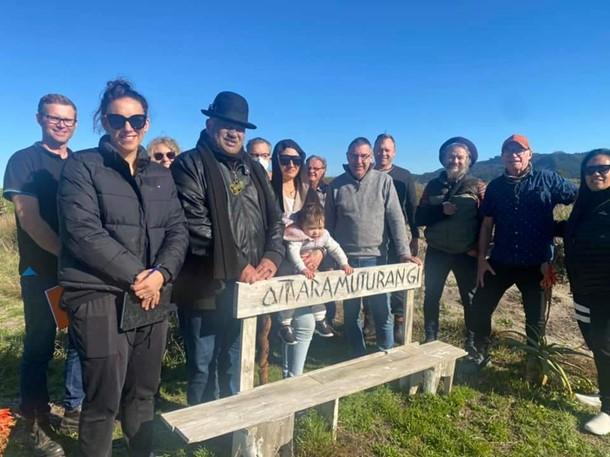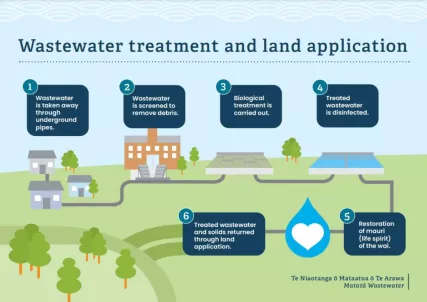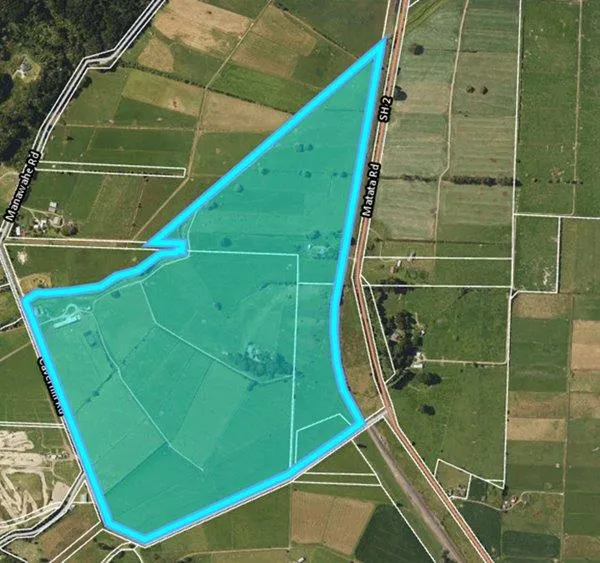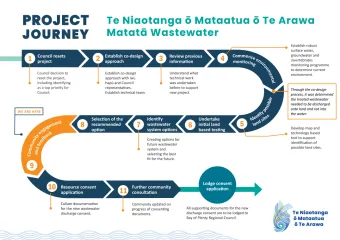Te Tauihu o te Waka – “Navigating the bow of the canoe, in the right direction, together”
The current wastewater management system in Matatā is failing. Despite ongoing efforts over several decades to establish a centralised wastewater solution, the town continues to struggle with poor wastewater management. The high groundwater levels and proximity to sensitive environmental areas render the current individual property septic tanks and disposal fields ineffective and unsuitable for the local environment. As a result, effluent from these onsite systems is seeping into the environment, contaminating land and water, including Te Awa o Te Atua (Matata Lagoon), a site of deep cultural and environmental significance that underpins the community and mana whenua connection to their rohe.
To address this, Whakatāne District Council, working alongside mana whenua through the Te Niaotanga ō Mataatua ō Te Arawa Co-Design Group, is developing a new wastewater system for Matatā.
Our co-design approach
This project has been co-designed with iwi and hapū partners, including Ngāti Rangitihi, Tūwharetoa ki Kawerau and Ngāti Awa. Together with the Council, Te Niaotanga ō Mataatua ō Te Arawa Co-Design Group has helped shape decisions at every step.
The approach supports tangata whenua aspirations to restore the mauri of Te Awa o Te Atua and the Tarawera Awa, and to protect culturally significant sites in and around Matatā.

Te Niaotanga ō Mataatua ō Te Arawa Co-Design Group and Technical Team members (July 2022)
The preferred solution
Comprehensive options analysis has been undertaken throughout the project. This has assessed both non-reticulation and reticulation options against agreed project objectives and technical criteria. Te Niaotanga ō Mataatua ō Te Arawa Co-Design Group used a collaborative design approach to consider options and determine a recommended wastewater system for Council to consider for implementation.
In September 2025, Council confirmed the preferred option: a moderate-scale, modular treatment system designed to service up to 700 homes at Tahi Hill Farm, with treated wastewater applied safely to land.
Honouring ancestral connections
Through kaitiakitanga practices, the iwi of Ngāti Awa, Ngāti Rangitihi and Tūwharetoa ki Kawerau have had a long-standing connection with the Tarawera Awa, their ancestral lands, wāhi tapu (sacred areas) and places of cultural and spiritual importance.
The township of Matatā descends in the direction of Te Awa o Te Atua. The vast wetland that borders and surrounds Te Awa o Te Atua has traditionally supported many species, including inanga and tuna.
The Waitepuru and Te Awatarariki streams emerge from the hills and flow through the township’s high-water table. This wider environment is rich with culturally significant sites and wāhi tapu.
Ngāti Rangitihi, Tūwharetoa ki Kawerau and Ngāti Awa, the tangata whenua of this rohe, carry an obligation inherited from their tupuna to protect, maintain and restore these places of importance, ensuring that future activities do not diminish their mauri or mana.
Why Matatā needs a wastewater scheme
- Many septic tank and disposal systems are ineffective and unsuitable for the local environment, due to high groundwater levels and proximity to sensitive environmental areas.
- Untreated wastewater is entering drains, rivers, groundwater and Te Awa o Te Atua.
- This creates health risks for the community and damages important natural and cultural environments.
This project will replace the current on-site systems with a new modern, reliable wastewater system
What this project will deliver
The new system will:
- Protect the environment and public health. Cleaner water in rivers, drains, Te Awa o Te Atua and the Tarawera Awa.
- Restore cultural values. Support tangata whenua to uphold their responsibilities as kaitiaki.
- Enable growth. Provide wastewater services for 400 homes initially, with capacity to expand to 700.
- Build resilience. Deliver safe, future-proofed infrastructure designed to last for generations.
 Click to enlarge |
Click to enlarge |
Cultural outcomes and aspirations
Restoring the mauri of Tarawera Awa ki Te Awa o Te Atua is central to this project. This aligns with the 2022 Treaty settlement for Ngāti Rangitihi, which established the Tarawera Awa Restoration Strategy Group. The group includes representatives from Ngāti Rangitihi, Ngāti Awa, Ngāti Mākino, Tūwharetoa ki Kawerau, and local and regional councils, who work together to restore and protect the awa and its catchment.
Ngāti Awa, Tūwharetoa ki Kawerau and Ngāti Rangitihi all share the aspiration of safeguarding the taiao. The new wastewater system will help restore the mauri of Tarawera Awa and Te Awa o Te Atua, while protecting the cultural landscape that is of deep importance to iwi.
Location of wastewater treatment plant
In 2024, Council purchased Tahi Hill Farm (56 hectares) near Awakaponga for the treatment plant and land application fields.
- Stage 1: Optimisation of the farm will provide enough capacity to service 400 homes.
- Stage 2: Future expansion will allow the system to service up to 700 homes.
The land will be recontoured and managed to ensure wastewater can be applied safely all year round.

Protecting the environment and building resilience
The treatment process will:
- Remove nutrients and harmful organisms before water is applied to land.
- Include robust monitoring of groundwater, surface water and soil.
- Be managed in line with cultural monitoring and environmental safeguards.
This ensures the scheme protects both people and the environment.
It's also about building resilience for the long term. By investing now in safe, modern infrastructure, we’re reducing risks and making sure the system can respond to future challenges, including climate change. The new wastewater system is being designed with a 20, 50 and even 100-year horizon in mind, so that it remains a reliable and sustainable asset for future generations.
Funding
In 2004, Council secured $6.7 million from the Ministry of Health to help fund the project. This subsidy must be used for capital costs associated with the construction of a consented reticulated wastewater system for Matatā. The Ministry of Health has indicated that this subsidy will need to be uplifted in the short term, due to the longevity of the subsidy being approved since 2004.
There are a number of different funding tools and levers local government can use to fund community and growth-related infrastructure. Work is underway with the Council to determine the most appropriate mix of funding sources and tools to deliver and operate the Matatā wastewater system. A business case is also being developed to help seek additional external co-investment funding from other partners.
Media
4 September 2025 - Councillors approve refined approach for Matatā wastewater solution
Whakatāne District Council Elected Members today approved the next steps for the Matatā Wastewater Project, endorsing a refined approach to delivering wastewater services for the community.
The decision confirms a moderate-scale, modular treatment system designed to service up to 700 homes, alongside moving forward with a resource consenting strategy.
October 2024 - Strategic land purchase paves way for Matatā Wastewater Project
The purchase of the property at 138 Caverhill Road marks a strategic move in the ongoing efforts to develop a much-needed wastewater treatment system for the area.
April 2023 - Steady progress being made on Matatā Wastewater project
The Matatā Wastewater project is progressing steadily with the project currently focused on environmental monitoring and identifying preferred discharge sites.
For any other information, email us at MatataWastewaterProject@whakatane.govt.nz
